Intellectual Disability Care: Comparing Nursing Practices Essay
VerifiedAdded on 2022/11/14
|13
|3604
|92
Essay
AI Summary
This essay provides a detailed analysis of nursing care for individuals with intellectual disabilities. It begins by comparing and contrasting two nurses' communication skills, attitudes, and behaviors using the ANSAT tool, highlighting the importance of therapeutic relationships, clear instructions, and effective communication strategies. The essay then delves into various communication strategies, including verbal, non-verbal, and visual methods, emphasizing their role in promoting health literacy and building trust. Furthermore, it explores the significance of health policies and legislations, such as the Human Rights Act and the National Disability Strategy, in ensuring equitable healthcare provision and addressing human rights breaches. The essay concludes by summarizing the key findings, emphasizing the need for competent nursing care, effective communication, and adherence to relevant policies and standards to improve outcomes for individuals with intellectual disabilities. This assignment, contributed by a student, is available on Desklib to assist other students with their studies.
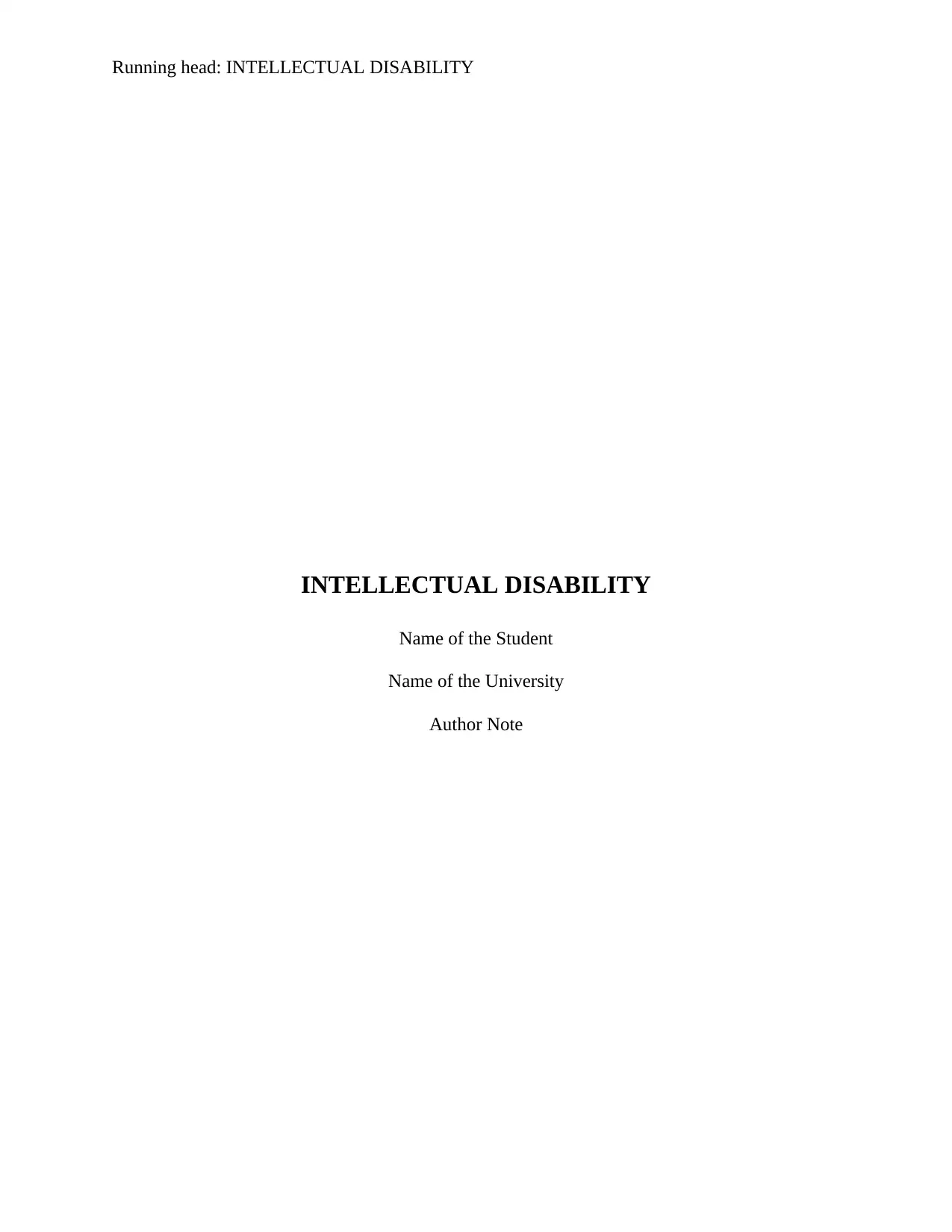
Running head: INTELLECTUAL DISABILITY
INTELLECTUAL DISABILITY
Name of the Student
Name of the University
Author Note
INTELLECTUAL DISABILITY
Name of the Student
Name of the University
Author Note
Paraphrase This Document
Need a fresh take? Get an instant paraphrase of this document with our AI Paraphraser
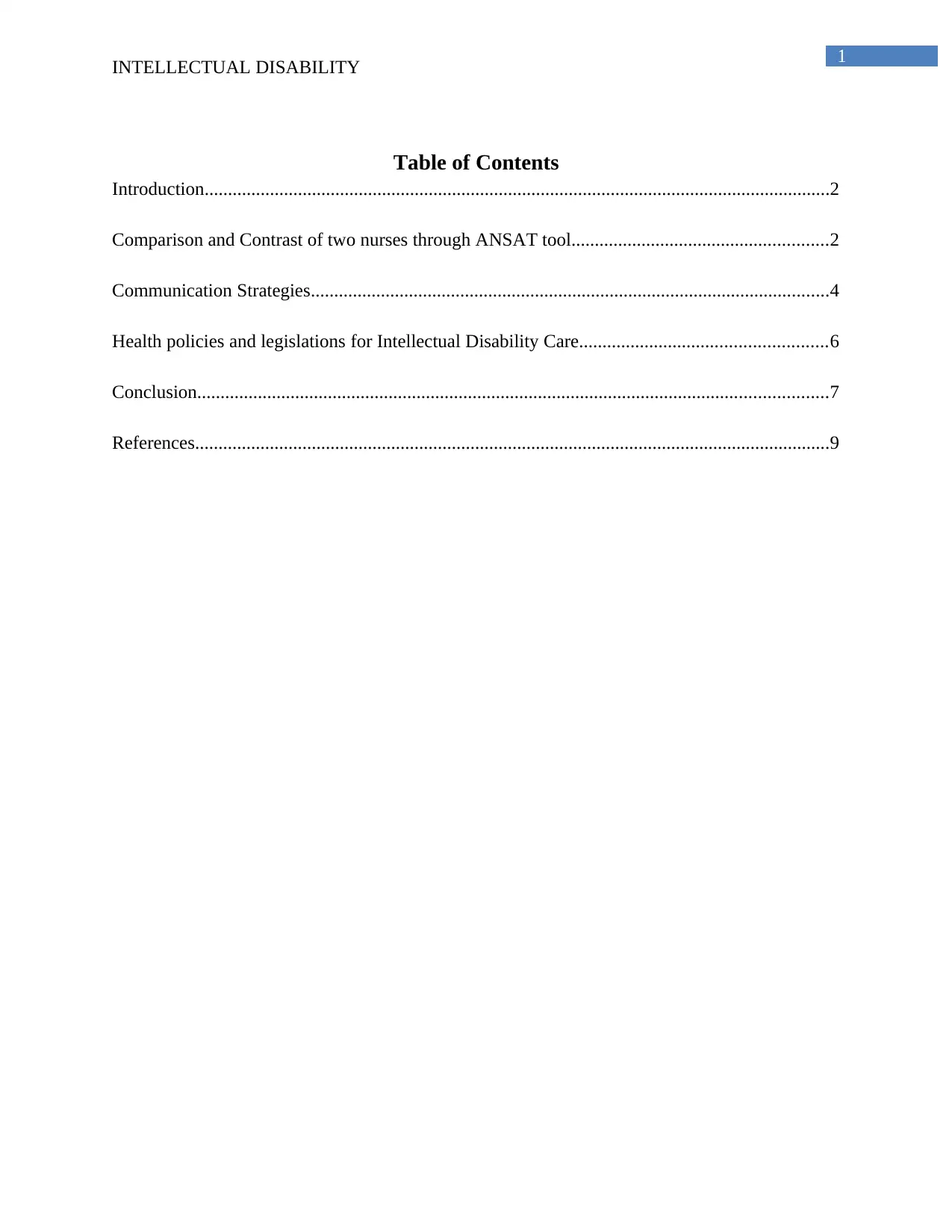
1
INTELLECTUAL DISABILITY
Table of Contents
Introduction......................................................................................................................................2
Comparison and Contrast of two nurses through ANSAT tool.......................................................2
Communication Strategies...............................................................................................................4
Health policies and legislations for Intellectual Disability Care.....................................................6
Conclusion.......................................................................................................................................7
References........................................................................................................................................9
INTELLECTUAL DISABILITY
Table of Contents
Introduction......................................................................................................................................2
Comparison and Contrast of two nurses through ANSAT tool.......................................................2
Communication Strategies...............................................................................................................4
Health policies and legislations for Intellectual Disability Care.....................................................6
Conclusion.......................................................................................................................................7
References........................................................................................................................................9
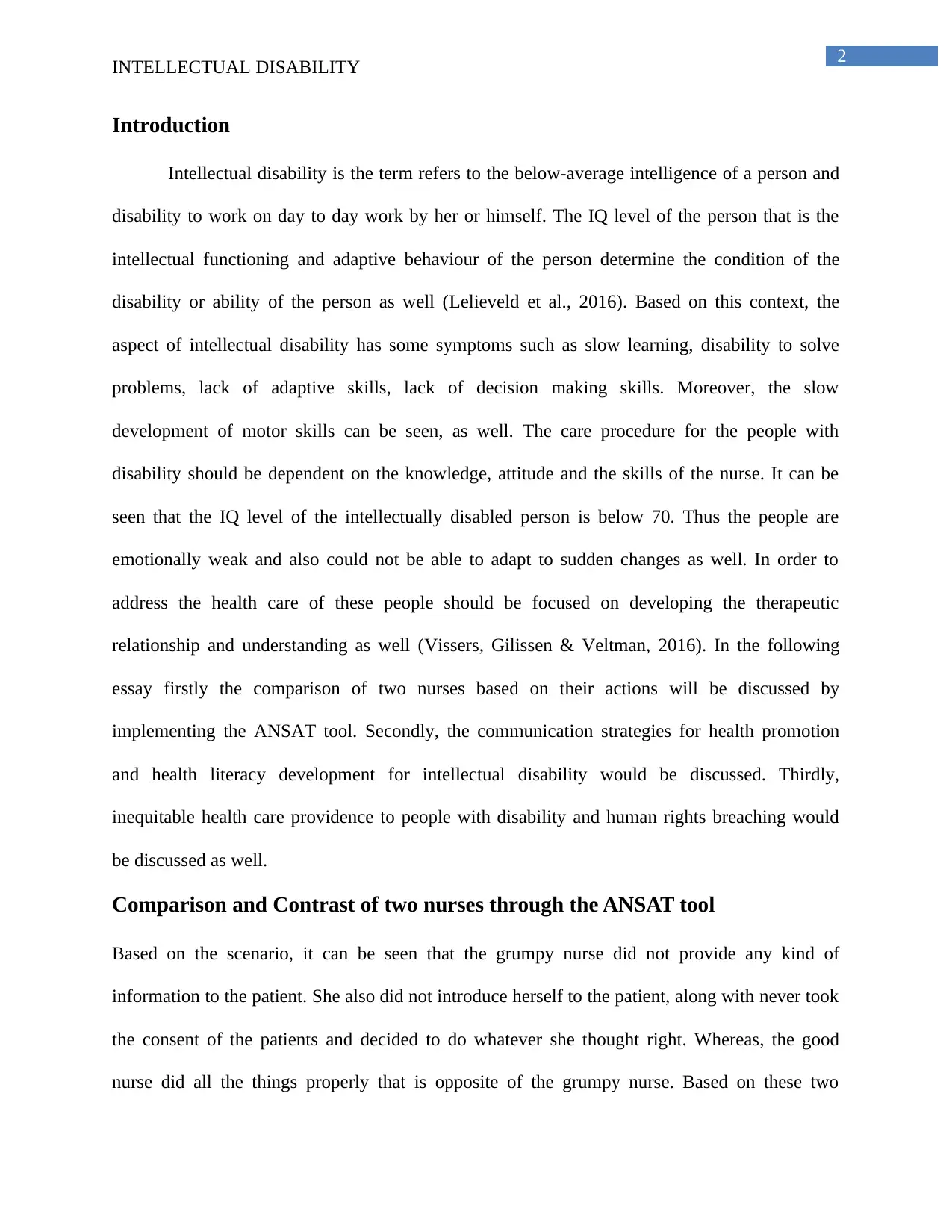
2
INTELLECTUAL DISABILITY
Introduction
Intellectual disability is the term refers to the below-average intelligence of a person and
disability to work on day to day work by her or himself. The IQ level of the person that is the
intellectual functioning and adaptive behaviour of the person determine the condition of the
disability or ability of the person as well (Lelieveld et al., 2016). Based on this context, the
aspect of intellectual disability has some symptoms such as slow learning, disability to solve
problems, lack of adaptive skills, lack of decision making skills. Moreover, the slow
development of motor skills can be seen, as well. The care procedure for the people with
disability should be dependent on the knowledge, attitude and the skills of the nurse. It can be
seen that the IQ level of the intellectually disabled person is below 70. Thus the people are
emotionally weak and also could not be able to adapt to sudden changes as well. In order to
address the health care of these people should be focused on developing the therapeutic
relationship and understanding as well (Vissers, Gilissen & Veltman, 2016). In the following
essay firstly the comparison of two nurses based on their actions will be discussed by
implementing the ANSAT tool. Secondly, the communication strategies for health promotion
and health literacy development for intellectual disability would be discussed. Thirdly,
inequitable health care providence to people with disability and human rights breaching would
be discussed as well.
Comparison and Contrast of two nurses through the ANSAT tool
Based on the scenario, it can be seen that the grumpy nurse did not provide any kind of
information to the patient. She also did not introduce herself to the patient, along with never took
the consent of the patients and decided to do whatever she thought right. Whereas, the good
nurse did all the things properly that is opposite of the grumpy nurse. Based on these two
INTELLECTUAL DISABILITY
Introduction
Intellectual disability is the term refers to the below-average intelligence of a person and
disability to work on day to day work by her or himself. The IQ level of the person that is the
intellectual functioning and adaptive behaviour of the person determine the condition of the
disability or ability of the person as well (Lelieveld et al., 2016). Based on this context, the
aspect of intellectual disability has some symptoms such as slow learning, disability to solve
problems, lack of adaptive skills, lack of decision making skills. Moreover, the slow
development of motor skills can be seen, as well. The care procedure for the people with
disability should be dependent on the knowledge, attitude and the skills of the nurse. It can be
seen that the IQ level of the intellectually disabled person is below 70. Thus the people are
emotionally weak and also could not be able to adapt to sudden changes as well. In order to
address the health care of these people should be focused on developing the therapeutic
relationship and understanding as well (Vissers, Gilissen & Veltman, 2016). In the following
essay firstly the comparison of two nurses based on their actions will be discussed by
implementing the ANSAT tool. Secondly, the communication strategies for health promotion
and health literacy development for intellectual disability would be discussed. Thirdly,
inequitable health care providence to people with disability and human rights breaching would
be discussed as well.
Comparison and Contrast of two nurses through the ANSAT tool
Based on the scenario, it can be seen that the grumpy nurse did not provide any kind of
information to the patient. She also did not introduce herself to the patient, along with never took
the consent of the patients and decided to do whatever she thought right. Whereas, the good
nurse did all the things properly that is opposite of the grumpy nurse. Based on these two
⊘ This is a preview!⊘
Do you want full access?
Subscribe today to unlock all pages.

Trusted by 1+ million students worldwide
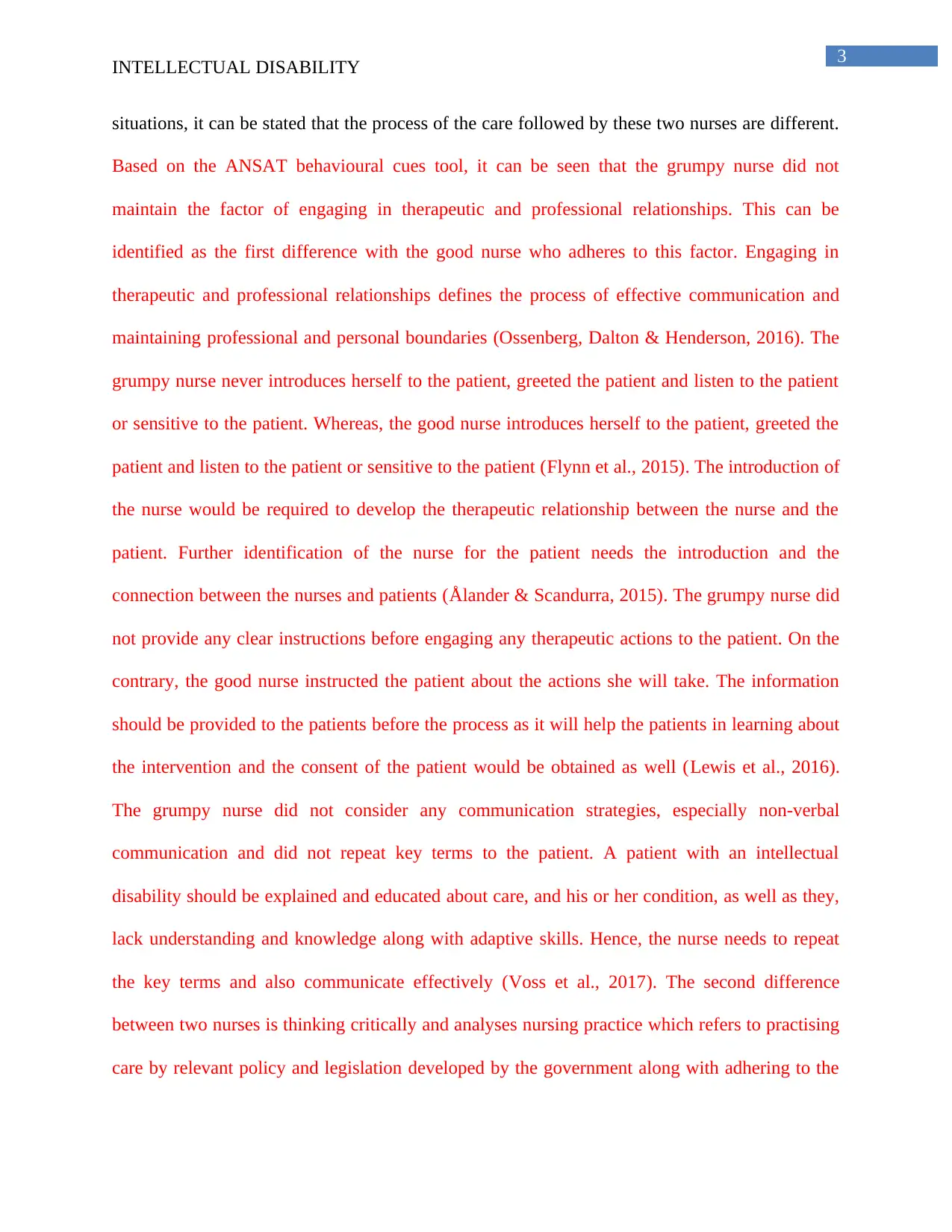
3
INTELLECTUAL DISABILITY
situations, it can be stated that the process of the care followed by these two nurses are different.
Based on the ANSAT behavioural cues tool, it can be seen that the grumpy nurse did not
maintain the factor of engaging in therapeutic and professional relationships. This can be
identified as the first difference with the good nurse who adheres to this factor. Engaging in
therapeutic and professional relationships defines the process of effective communication and
maintaining professional and personal boundaries (Ossenberg, Dalton & Henderson, 2016). The
grumpy nurse never introduces herself to the patient, greeted the patient and listen to the patient
or sensitive to the patient. Whereas, the good nurse introduces herself to the patient, greeted the
patient and listen to the patient or sensitive to the patient (Flynn et al., 2015). The introduction of
the nurse would be required to develop the therapeutic relationship between the nurse and the
patient. Further identification of the nurse for the patient needs the introduction and the
connection between the nurses and patients (Ålander & Scandurra, 2015). The grumpy nurse did
not provide any clear instructions before engaging any therapeutic actions to the patient. On the
contrary, the good nurse instructed the patient about the actions she will take. The information
should be provided to the patients before the process as it will help the patients in learning about
the intervention and the consent of the patient would be obtained as well (Lewis et al., 2016).
The grumpy nurse did not consider any communication strategies, especially non-verbal
communication and did not repeat key terms to the patient. A patient with an intellectual
disability should be explained and educated about care, and his or her condition, as well as they,
lack understanding and knowledge along with adaptive skills. Hence, the nurse needs to repeat
the key terms and also communicate effectively (Voss et al., 2017). The second difference
between two nurses is thinking critically and analyses nursing practice which refers to practising
care by relevant policy and legislation developed by the government along with adhering to the
INTELLECTUAL DISABILITY
situations, it can be stated that the process of the care followed by these two nurses are different.
Based on the ANSAT behavioural cues tool, it can be seen that the grumpy nurse did not
maintain the factor of engaging in therapeutic and professional relationships. This can be
identified as the first difference with the good nurse who adheres to this factor. Engaging in
therapeutic and professional relationships defines the process of effective communication and
maintaining professional and personal boundaries (Ossenberg, Dalton & Henderson, 2016). The
grumpy nurse never introduces herself to the patient, greeted the patient and listen to the patient
or sensitive to the patient. Whereas, the good nurse introduces herself to the patient, greeted the
patient and listen to the patient or sensitive to the patient (Flynn et al., 2015). The introduction of
the nurse would be required to develop the therapeutic relationship between the nurse and the
patient. Further identification of the nurse for the patient needs the introduction and the
connection between the nurses and patients (Ålander & Scandurra, 2015). The grumpy nurse did
not provide any clear instructions before engaging any therapeutic actions to the patient. On the
contrary, the good nurse instructed the patient about the actions she will take. The information
should be provided to the patients before the process as it will help the patients in learning about
the intervention and the consent of the patient would be obtained as well (Lewis et al., 2016).
The grumpy nurse did not consider any communication strategies, especially non-verbal
communication and did not repeat key terms to the patient. A patient with an intellectual
disability should be explained and educated about care, and his or her condition, as well as they,
lack understanding and knowledge along with adaptive skills. Hence, the nurse needs to repeat
the key terms and also communicate effectively (Voss et al., 2017). The second difference
between two nurses is thinking critically and analyses nursing practice which refers to practising
care by relevant policy and legislation developed by the government along with adhering to the
Paraphrase This Document
Need a fresh take? Get an instant paraphrase of this document with our AI Paraphraser
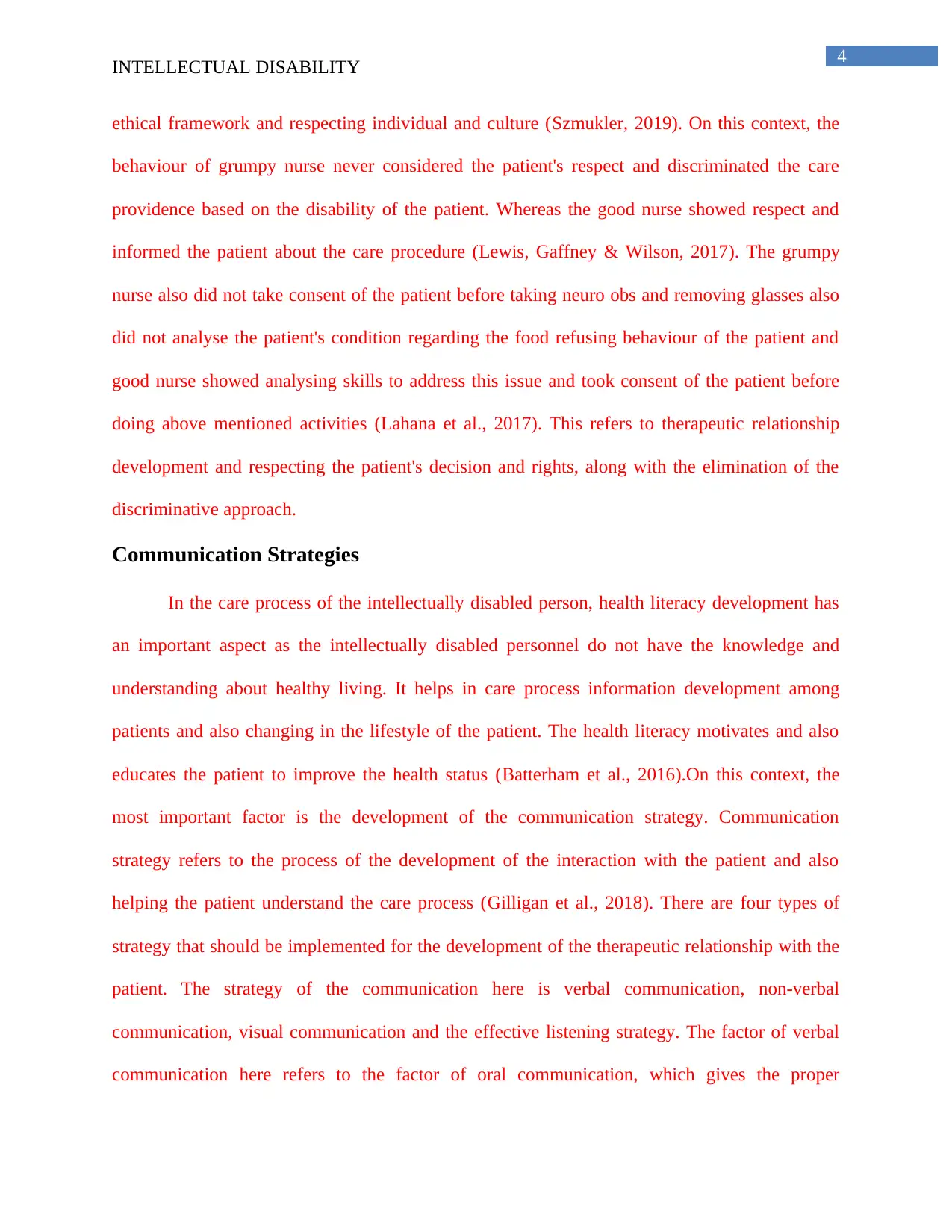
4
INTELLECTUAL DISABILITY
ethical framework and respecting individual and culture (Szmukler, 2019). On this context, the
behaviour of grumpy nurse never considered the patient's respect and discriminated the care
providence based on the disability of the patient. Whereas the good nurse showed respect and
informed the patient about the care procedure (Lewis, Gaffney & Wilson, 2017). The grumpy
nurse also did not take consent of the patient before taking neuro obs and removing glasses also
did not analyse the patient's condition regarding the food refusing behaviour of the patient and
good nurse showed analysing skills to address this issue and took consent of the patient before
doing above mentioned activities (Lahana et al., 2017). This refers to therapeutic relationship
development and respecting the patient's decision and rights, along with the elimination of the
discriminative approach.
Communication Strategies
In the care process of the intellectually disabled person, health literacy development has
an important aspect as the intellectually disabled personnel do not have the knowledge and
understanding about healthy living. It helps in care process information development among
patients and also changing in the lifestyle of the patient. The health literacy motivates and also
educates the patient to improve the health status (Batterham et al., 2016).On this context, the
most important factor is the development of the communication strategy. Communication
strategy refers to the process of the development of the interaction with the patient and also
helping the patient understand the care process (Gilligan et al., 2018). There are four types of
strategy that should be implemented for the development of the therapeutic relationship with the
patient. The strategy of the communication here is verbal communication, non-verbal
communication, visual communication and the effective listening strategy. The factor of verbal
communication here refers to the factor of oral communication, which gives the proper
INTELLECTUAL DISABILITY
ethical framework and respecting individual and culture (Szmukler, 2019). On this context, the
behaviour of grumpy nurse never considered the patient's respect and discriminated the care
providence based on the disability of the patient. Whereas the good nurse showed respect and
informed the patient about the care procedure (Lewis, Gaffney & Wilson, 2017). The grumpy
nurse also did not take consent of the patient before taking neuro obs and removing glasses also
did not analyse the patient's condition regarding the food refusing behaviour of the patient and
good nurse showed analysing skills to address this issue and took consent of the patient before
doing above mentioned activities (Lahana et al., 2017). This refers to therapeutic relationship
development and respecting the patient's decision and rights, along with the elimination of the
discriminative approach.
Communication Strategies
In the care process of the intellectually disabled person, health literacy development has
an important aspect as the intellectually disabled personnel do not have the knowledge and
understanding about healthy living. It helps in care process information development among
patients and also changing in the lifestyle of the patient. The health literacy motivates and also
educates the patient to improve the health status (Batterham et al., 2016).On this context, the
most important factor is the development of the communication strategy. Communication
strategy refers to the process of the development of the interaction with the patient and also
helping the patient understand the care process (Gilligan et al., 2018). There are four types of
strategy that should be implemented for the development of the therapeutic relationship with the
patient. The strategy of the communication here is verbal communication, non-verbal
communication, visual communication and the effective listening strategy. The factor of verbal
communication here refers to the factor of oral communication, which gives the proper
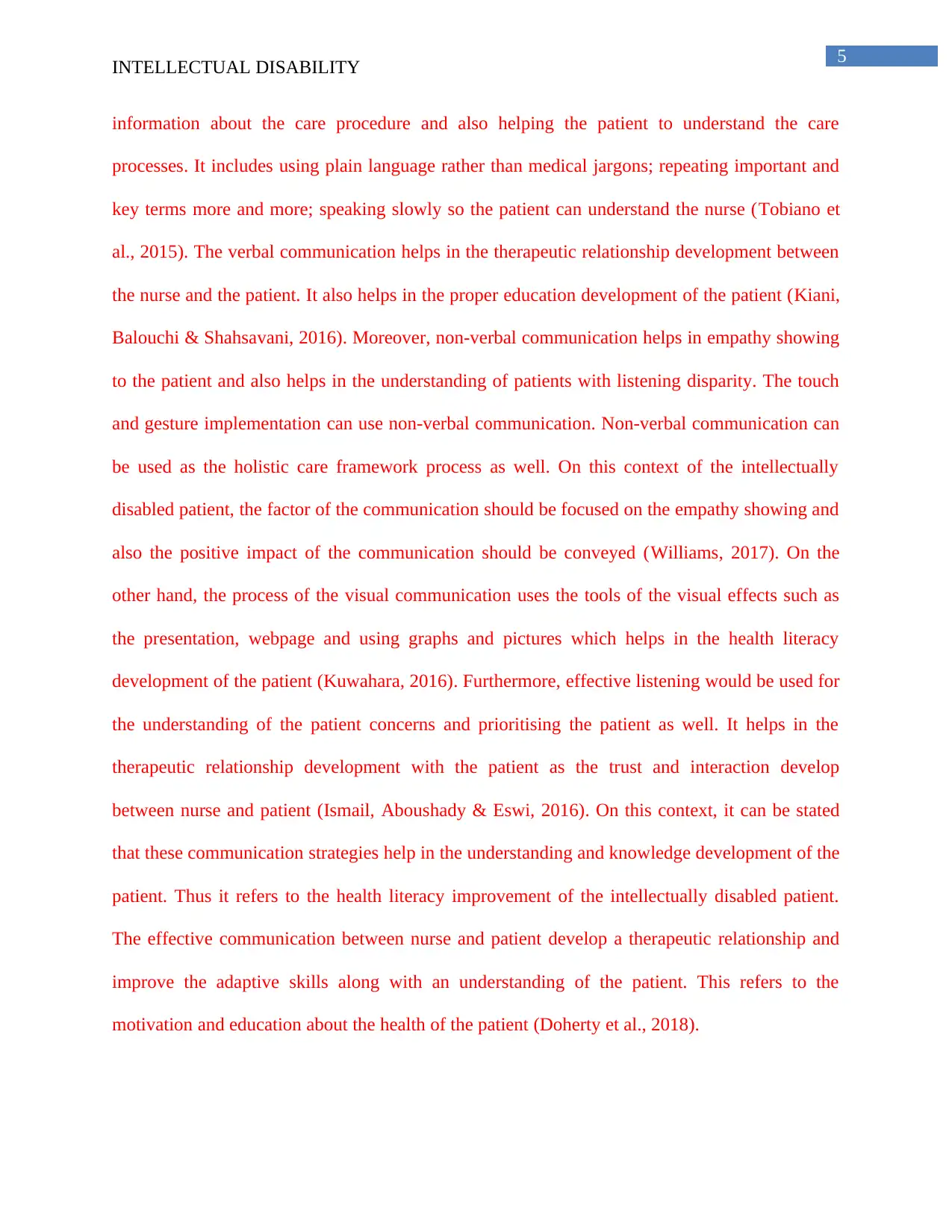
5
INTELLECTUAL DISABILITY
information about the care procedure and also helping the patient to understand the care
processes. It includes using plain language rather than medical jargons; repeating important and
key terms more and more; speaking slowly so the patient can understand the nurse (Tobiano et
al., 2015). The verbal communication helps in the therapeutic relationship development between
the nurse and the patient. It also helps in the proper education development of the patient (Kiani,
Balouchi & Shahsavani, 2016). Moreover, non-verbal communication helps in empathy showing
to the patient and also helps in the understanding of patients with listening disparity. The touch
and gesture implementation can use non-verbal communication. Non-verbal communication can
be used as the holistic care framework process as well. On this context of the intellectually
disabled patient, the factor of the communication should be focused on the empathy showing and
also the positive impact of the communication should be conveyed (Williams, 2017). On the
other hand, the process of the visual communication uses the tools of the visual effects such as
the presentation, webpage and using graphs and pictures which helps in the health literacy
development of the patient (Kuwahara, 2016). Furthermore, effective listening would be used for
the understanding of the patient concerns and prioritising the patient as well. It helps in the
therapeutic relationship development with the patient as the trust and interaction develop
between nurse and patient (Ismail, Aboushady & Eswi, 2016). On this context, it can be stated
that these communication strategies help in the understanding and knowledge development of the
patient. Thus it refers to the health literacy improvement of the intellectually disabled patient.
The effective communication between nurse and patient develop a therapeutic relationship and
improve the adaptive skills along with an understanding of the patient. This refers to the
motivation and education about the health of the patient (Doherty et al., 2018).
INTELLECTUAL DISABILITY
information about the care procedure and also helping the patient to understand the care
processes. It includes using plain language rather than medical jargons; repeating important and
key terms more and more; speaking slowly so the patient can understand the nurse (Tobiano et
al., 2015). The verbal communication helps in the therapeutic relationship development between
the nurse and the patient. It also helps in the proper education development of the patient (Kiani,
Balouchi & Shahsavani, 2016). Moreover, non-verbal communication helps in empathy showing
to the patient and also helps in the understanding of patients with listening disparity. The touch
and gesture implementation can use non-verbal communication. Non-verbal communication can
be used as the holistic care framework process as well. On this context of the intellectually
disabled patient, the factor of the communication should be focused on the empathy showing and
also the positive impact of the communication should be conveyed (Williams, 2017). On the
other hand, the process of the visual communication uses the tools of the visual effects such as
the presentation, webpage and using graphs and pictures which helps in the health literacy
development of the patient (Kuwahara, 2016). Furthermore, effective listening would be used for
the understanding of the patient concerns and prioritising the patient as well. It helps in the
therapeutic relationship development with the patient as the trust and interaction develop
between nurse and patient (Ismail, Aboushady & Eswi, 2016). On this context, it can be stated
that these communication strategies help in the understanding and knowledge development of the
patient. Thus it refers to the health literacy improvement of the intellectually disabled patient.
The effective communication between nurse and patient develop a therapeutic relationship and
improve the adaptive skills along with an understanding of the patient. This refers to the
motivation and education about the health of the patient (Doherty et al., 2018).
⊘ This is a preview!⊘
Do you want full access?
Subscribe today to unlock all pages.

Trusted by 1+ million students worldwide
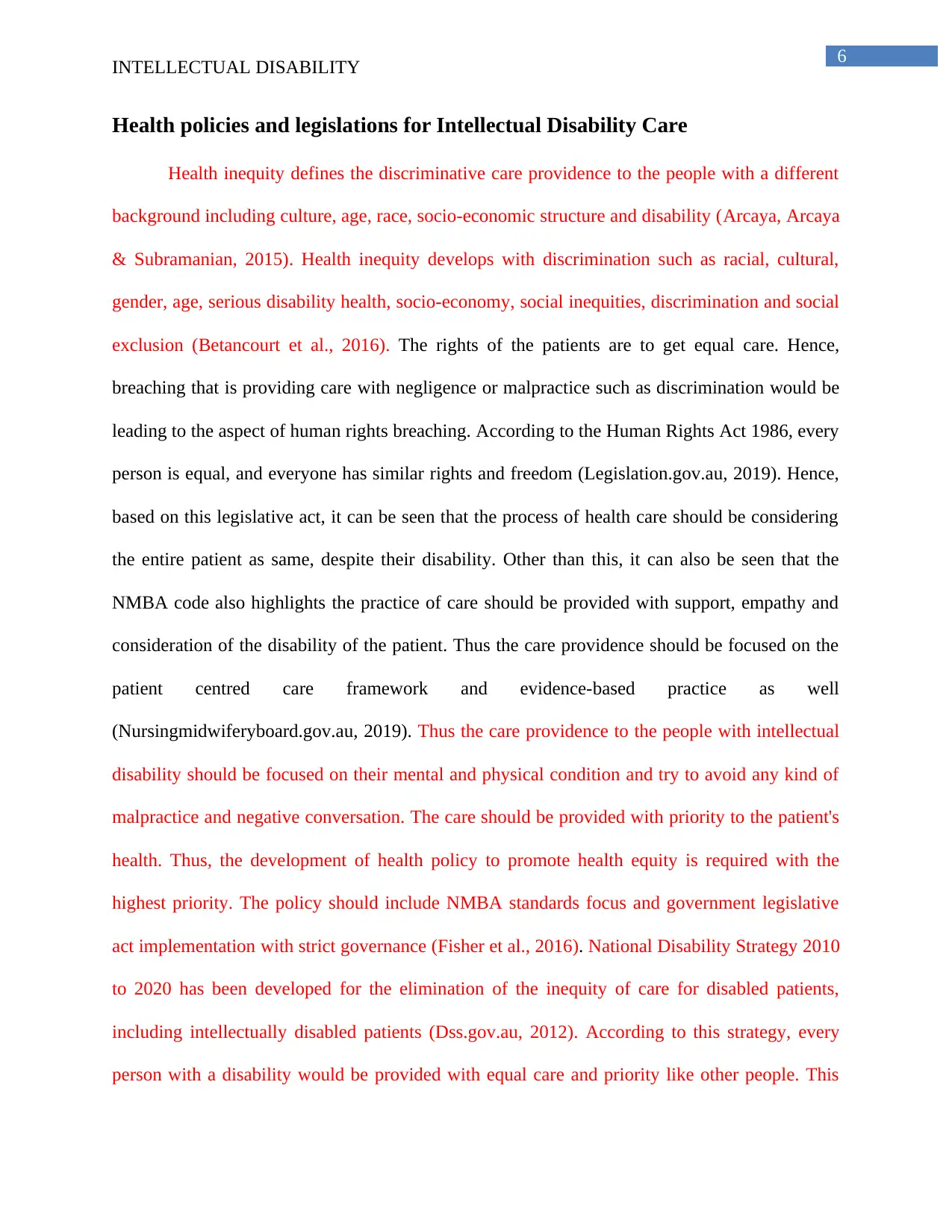
6
INTELLECTUAL DISABILITY
Health policies and legislations for Intellectual Disability Care
Health inequity defines the discriminative care providence to the people with a different
background including culture, age, race, socio-economic structure and disability (Arcaya, Arcaya
& Subramanian, 2015). Health inequity develops with discrimination such as racial, cultural,
gender, age, serious disability health, socio-economy, social inequities, discrimination and social
exclusion (Betancourt et al., 2016). The rights of the patients are to get equal care. Hence,
breaching that is providing care with negligence or malpractice such as discrimination would be
leading to the aspect of human rights breaching. According to the Human Rights Act 1986, every
person is equal, and everyone has similar rights and freedom (Legislation.gov.au, 2019). Hence,
based on this legislative act, it can be seen that the process of health care should be considering
the entire patient as same, despite their disability. Other than this, it can also be seen that the
NMBA code also highlights the practice of care should be provided with support, empathy and
consideration of the disability of the patient. Thus the care providence should be focused on the
patient centred care framework and evidence-based practice as well
(Nursingmidwiferyboard.gov.au, 2019). Thus the care providence to the people with intellectual
disability should be focused on their mental and physical condition and try to avoid any kind of
malpractice and negative conversation. The care should be provided with priority to the patient's
health. Thus, the development of health policy to promote health equity is required with the
highest priority. The policy should include NMBA standards focus and government legislative
act implementation with strict governance (Fisher et al., 2016). National Disability Strategy 2010
to 2020 has been developed for the elimination of the inequity of care for disabled patients,
including intellectually disabled patients (Dss.gov.au, 2012). According to this strategy, every
person with a disability would be provided with equal care and priority like other people. This
INTELLECTUAL DISABILITY
Health policies and legislations for Intellectual Disability Care
Health inequity defines the discriminative care providence to the people with a different
background including culture, age, race, socio-economic structure and disability (Arcaya, Arcaya
& Subramanian, 2015). Health inequity develops with discrimination such as racial, cultural,
gender, age, serious disability health, socio-economy, social inequities, discrimination and social
exclusion (Betancourt et al., 2016). The rights of the patients are to get equal care. Hence,
breaching that is providing care with negligence or malpractice such as discrimination would be
leading to the aspect of human rights breaching. According to the Human Rights Act 1986, every
person is equal, and everyone has similar rights and freedom (Legislation.gov.au, 2019). Hence,
based on this legislative act, it can be seen that the process of health care should be considering
the entire patient as same, despite their disability. Other than this, it can also be seen that the
NMBA code also highlights the practice of care should be provided with support, empathy and
consideration of the disability of the patient. Thus the care providence should be focused on the
patient centred care framework and evidence-based practice as well
(Nursingmidwiferyboard.gov.au, 2019). Thus the care providence to the people with intellectual
disability should be focused on their mental and physical condition and try to avoid any kind of
malpractice and negative conversation. The care should be provided with priority to the patient's
health. Thus, the development of health policy to promote health equity is required with the
highest priority. The policy should include NMBA standards focus and government legislative
act implementation with strict governance (Fisher et al., 2016). National Disability Strategy 2010
to 2020 has been developed for the elimination of the inequity of care for disabled patients,
including intellectually disabled patients (Dss.gov.au, 2012). According to this strategy, every
person with a disability would be provided with equal care and priority like other people. This
Paraphrase This Document
Need a fresh take? Get an instant paraphrase of this document with our AI Paraphraser
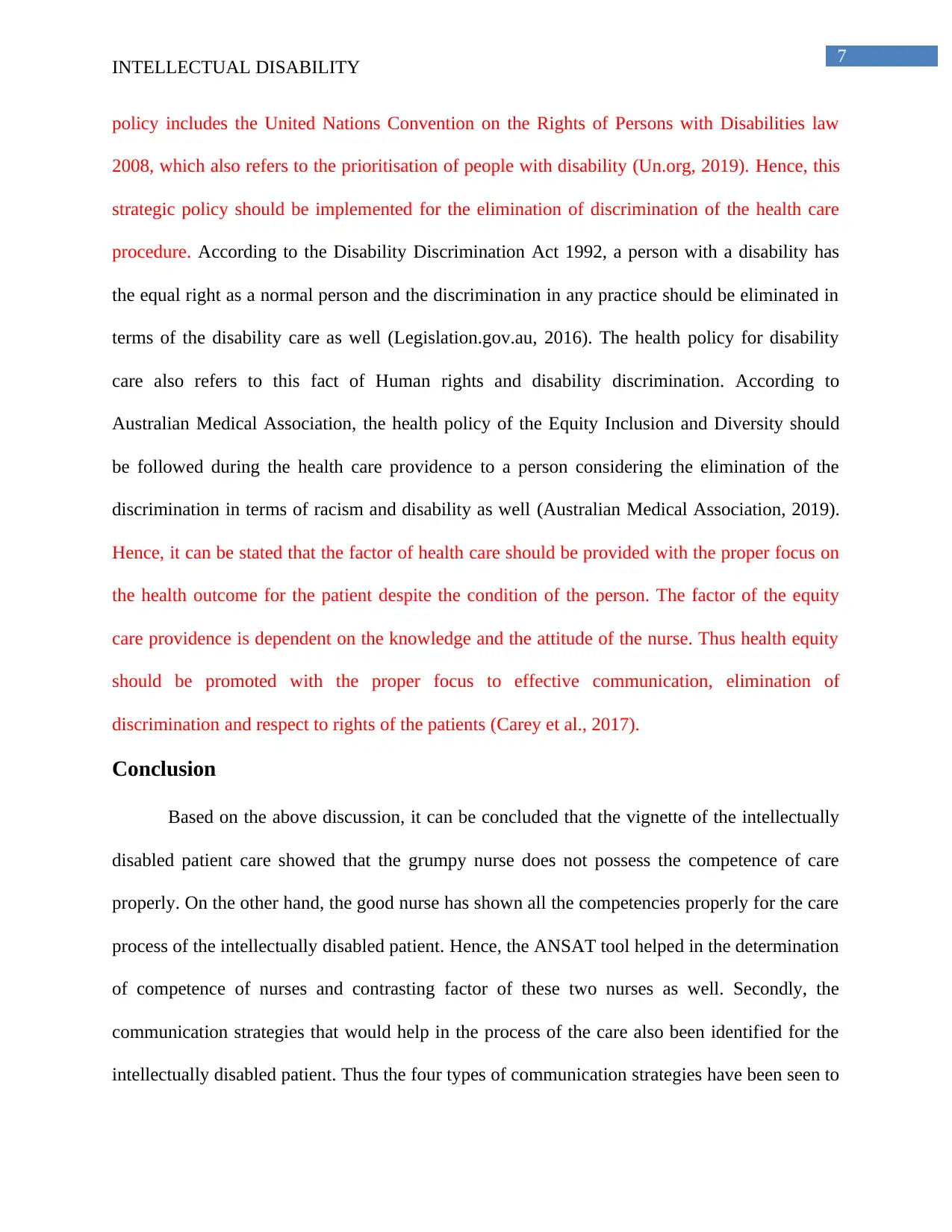
7
INTELLECTUAL DISABILITY
policy includes the United Nations Convention on the Rights of Persons with Disabilities law
2008, which also refers to the prioritisation of people with disability (Un.org, 2019). Hence, this
strategic policy should be implemented for the elimination of discrimination of the health care
procedure. According to the Disability Discrimination Act 1992, a person with a disability has
the equal right as a normal person and the discrimination in any practice should be eliminated in
terms of the disability care as well (Legislation.gov.au, 2016). The health policy for disability
care also refers to this fact of Human rights and disability discrimination. According to
Australian Medical Association, the health policy of the Equity Inclusion and Diversity should
be followed during the health care providence to a person considering the elimination of the
discrimination in terms of racism and disability as well (Australian Medical Association, 2019).
Hence, it can be stated that the factor of health care should be provided with the proper focus on
the health outcome for the patient despite the condition of the person. The factor of the equity
care providence is dependent on the knowledge and the attitude of the nurse. Thus health equity
should be promoted with the proper focus to effective communication, elimination of
discrimination and respect to rights of the patients (Carey et al., 2017).
Conclusion
Based on the above discussion, it can be concluded that the vignette of the intellectually
disabled patient care showed that the grumpy nurse does not possess the competence of care
properly. On the other hand, the good nurse has shown all the competencies properly for the care
process of the intellectually disabled patient. Hence, the ANSAT tool helped in the determination
of competence of nurses and contrasting factor of these two nurses as well. Secondly, the
communication strategies that would help in the process of the care also been identified for the
intellectually disabled patient. Thus the four types of communication strategies have been seen to
INTELLECTUAL DISABILITY
policy includes the United Nations Convention on the Rights of Persons with Disabilities law
2008, which also refers to the prioritisation of people with disability (Un.org, 2019). Hence, this
strategic policy should be implemented for the elimination of discrimination of the health care
procedure. According to the Disability Discrimination Act 1992, a person with a disability has
the equal right as a normal person and the discrimination in any practice should be eliminated in
terms of the disability care as well (Legislation.gov.au, 2016). The health policy for disability
care also refers to this fact of Human rights and disability discrimination. According to
Australian Medical Association, the health policy of the Equity Inclusion and Diversity should
be followed during the health care providence to a person considering the elimination of the
discrimination in terms of racism and disability as well (Australian Medical Association, 2019).
Hence, it can be stated that the factor of health care should be provided with the proper focus on
the health outcome for the patient despite the condition of the person. The factor of the equity
care providence is dependent on the knowledge and the attitude of the nurse. Thus health equity
should be promoted with the proper focus to effective communication, elimination of
discrimination and respect to rights of the patients (Carey et al., 2017).
Conclusion
Based on the above discussion, it can be concluded that the vignette of the intellectually
disabled patient care showed that the grumpy nurse does not possess the competence of care
properly. On the other hand, the good nurse has shown all the competencies properly for the care
process of the intellectually disabled patient. Hence, the ANSAT tool helped in the determination
of competence of nurses and contrasting factor of these two nurses as well. Secondly, the
communication strategies that would help in the process of the care also been identified for the
intellectually disabled patient. Thus the four types of communication strategies have been seen to
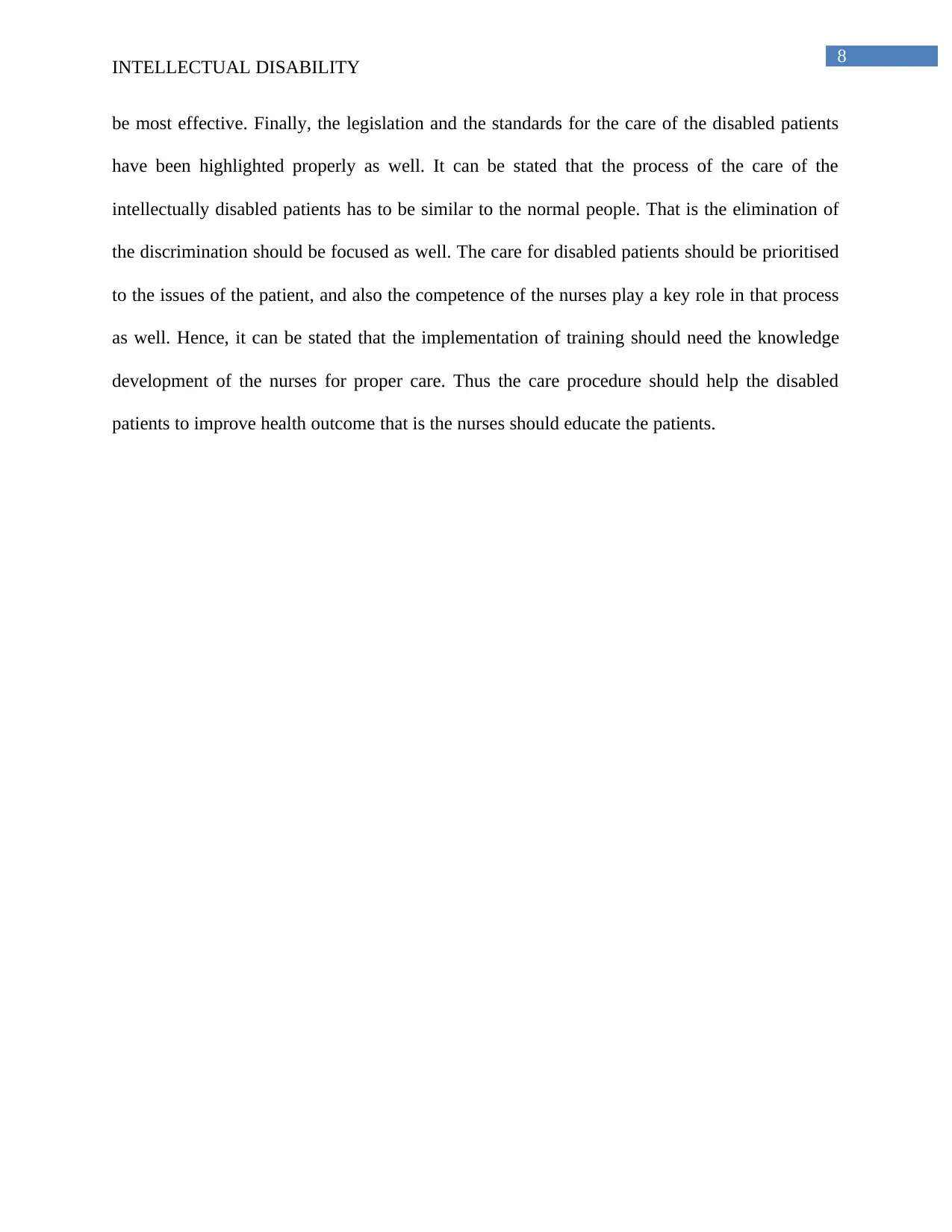
8
INTELLECTUAL DISABILITY
be most effective. Finally, the legislation and the standards for the care of the disabled patients
have been highlighted properly as well. It can be stated that the process of the care of the
intellectually disabled patients has to be similar to the normal people. That is the elimination of
the discrimination should be focused as well. The care for disabled patients should be prioritised
to the issues of the patient, and also the competence of the nurses play a key role in that process
as well. Hence, it can be stated that the implementation of training should need the knowledge
development of the nurses for proper care. Thus the care procedure should help the disabled
patients to improve health outcome that is the nurses should educate the patients.
INTELLECTUAL DISABILITY
be most effective. Finally, the legislation and the standards for the care of the disabled patients
have been highlighted properly as well. It can be stated that the process of the care of the
intellectually disabled patients has to be similar to the normal people. That is the elimination of
the discrimination should be focused as well. The care for disabled patients should be prioritised
to the issues of the patient, and also the competence of the nurses play a key role in that process
as well. Hence, it can be stated that the implementation of training should need the knowledge
development of the nurses for proper care. Thus the care procedure should help the disabled
patients to improve health outcome that is the nurses should educate the patients.
⊘ This is a preview!⊘
Do you want full access?
Subscribe today to unlock all pages.

Trusted by 1+ million students worldwide
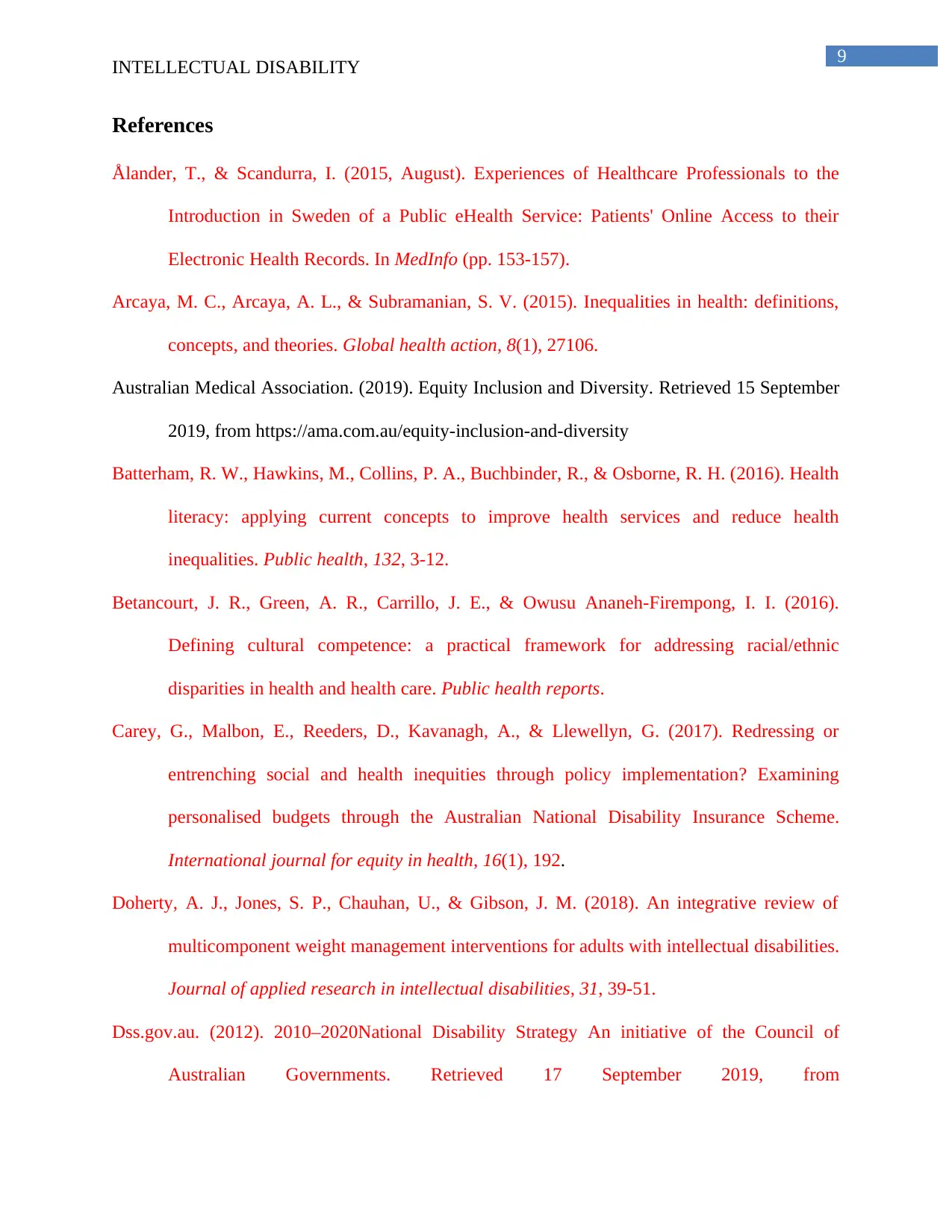
9
INTELLECTUAL DISABILITY
References
Ålander, T., & Scandurra, I. (2015, August). Experiences of Healthcare Professionals to the
Introduction in Sweden of a Public eHealth Service: Patients' Online Access to their
Electronic Health Records. In MedInfo (pp. 153-157).
Arcaya, M. C., Arcaya, A. L., & Subramanian, S. V. (2015). Inequalities in health: definitions,
concepts, and theories. Global health action, 8(1), 27106.
Australian Medical Association. (2019). Equity Inclusion and Diversity. Retrieved 15 September
2019, from https://ama.com.au/equity-inclusion-and-diversity
Batterham, R. W., Hawkins, M., Collins, P. A., Buchbinder, R., & Osborne, R. H. (2016). Health
literacy: applying current concepts to improve health services and reduce health
inequalities. Public health, 132, 3-12.
Betancourt, J. R., Green, A. R., Carrillo, J. E., & Owusu Ananeh-Firempong, I. I. (2016).
Defining cultural competence: a practical framework for addressing racial/ethnic
disparities in health and health care. Public health reports.
Carey, G., Malbon, E., Reeders, D., Kavanagh, A., & Llewellyn, G. (2017). Redressing or
entrenching social and health inequities through policy implementation? Examining
personalised budgets through the Australian National Disability Insurance Scheme.
International journal for equity in health, 16(1), 192.
Doherty, A. J., Jones, S. P., Chauhan, U., & Gibson, J. M. (2018). An integrative review of
multicomponent weight management interventions for adults with intellectual disabilities.
Journal of applied research in intellectual disabilities, 31, 39-51.
Dss.gov.au. (2012). 2010–2020National Disability Strategy An initiative of the Council of
Australian Governments. Retrieved 17 September 2019, from
INTELLECTUAL DISABILITY
References
Ålander, T., & Scandurra, I. (2015, August). Experiences of Healthcare Professionals to the
Introduction in Sweden of a Public eHealth Service: Patients' Online Access to their
Electronic Health Records. In MedInfo (pp. 153-157).
Arcaya, M. C., Arcaya, A. L., & Subramanian, S. V. (2015). Inequalities in health: definitions,
concepts, and theories. Global health action, 8(1), 27106.
Australian Medical Association. (2019). Equity Inclusion and Diversity. Retrieved 15 September
2019, from https://ama.com.au/equity-inclusion-and-diversity
Batterham, R. W., Hawkins, M., Collins, P. A., Buchbinder, R., & Osborne, R. H. (2016). Health
literacy: applying current concepts to improve health services and reduce health
inequalities. Public health, 132, 3-12.
Betancourt, J. R., Green, A. R., Carrillo, J. E., & Owusu Ananeh-Firempong, I. I. (2016).
Defining cultural competence: a practical framework for addressing racial/ethnic
disparities in health and health care. Public health reports.
Carey, G., Malbon, E., Reeders, D., Kavanagh, A., & Llewellyn, G. (2017). Redressing or
entrenching social and health inequities through policy implementation? Examining
personalised budgets through the Australian National Disability Insurance Scheme.
International journal for equity in health, 16(1), 192.
Doherty, A. J., Jones, S. P., Chauhan, U., & Gibson, J. M. (2018). An integrative review of
multicomponent weight management interventions for adults with intellectual disabilities.
Journal of applied research in intellectual disabilities, 31, 39-51.
Dss.gov.au. (2012). 2010–2020National Disability Strategy An initiative of the Council of
Australian Governments. Retrieved 17 September 2019, from
Paraphrase This Document
Need a fresh take? Get an instant paraphrase of this document with our AI Paraphraser
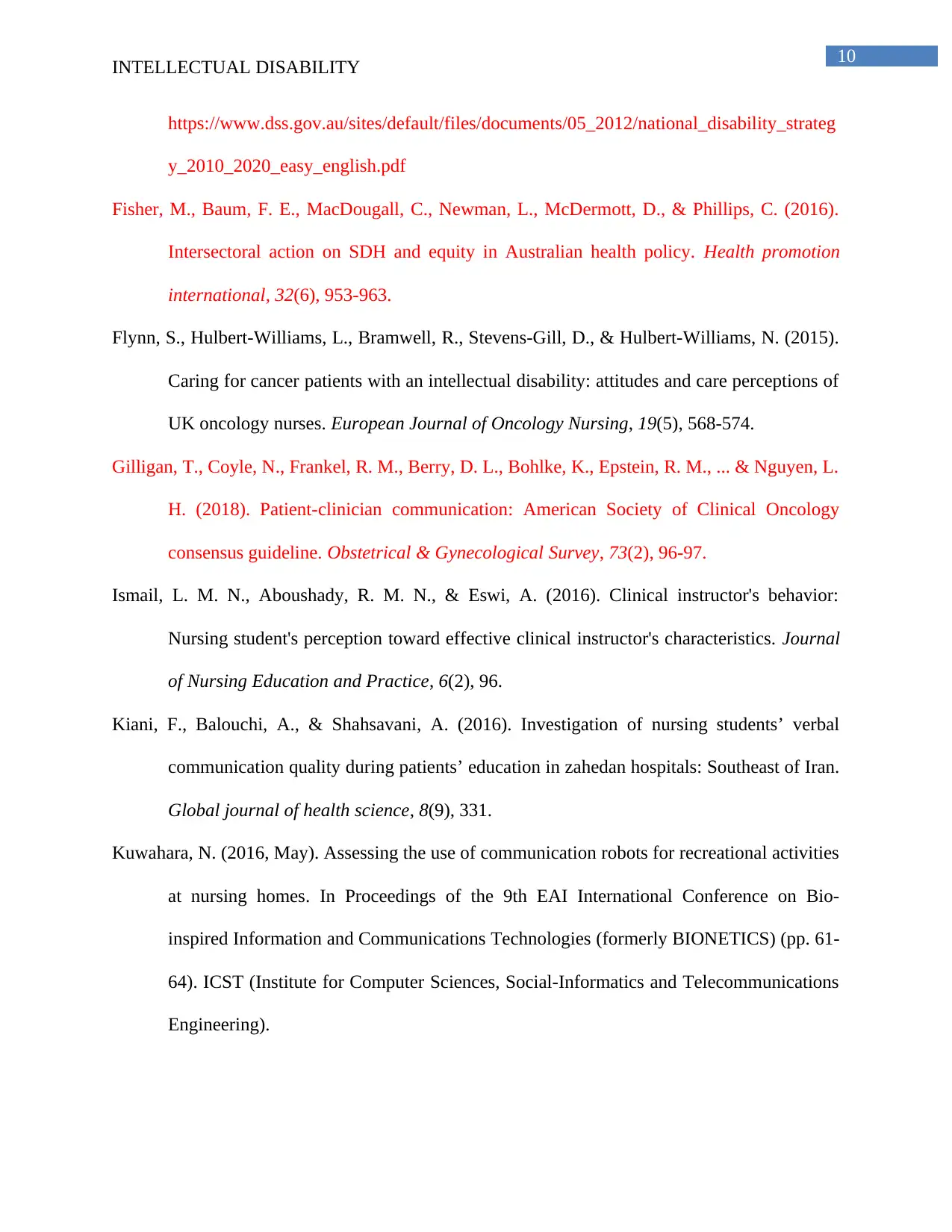
10
INTELLECTUAL DISABILITY
https://www.dss.gov.au/sites/default/files/documents/05_2012/national_disability_strateg
y_2010_2020_easy_english.pdf
Fisher, M., Baum, F. E., MacDougall, C., Newman, L., McDermott, D., & Phillips, C. (2016).
Intersectoral action on SDH and equity in Australian health policy. Health promotion
international, 32(6), 953-963.
Flynn, S., Hulbert-Williams, L., Bramwell, R., Stevens-Gill, D., & Hulbert-Williams, N. (2015).
Caring for cancer patients with an intellectual disability: attitudes and care perceptions of
UK oncology nurses. European Journal of Oncology Nursing, 19(5), 568-574.
Gilligan, T., Coyle, N., Frankel, R. M., Berry, D. L., Bohlke, K., Epstein, R. M., ... & Nguyen, L.
H. (2018). Patient-clinician communication: American Society of Clinical Oncology
consensus guideline. Obstetrical & Gynecological Survey, 73(2), 96-97.
Ismail, L. M. N., Aboushady, R. M. N., & Eswi, A. (2016). Clinical instructor's behavior:
Nursing student's perception toward effective clinical instructor's characteristics. Journal
of Nursing Education and Practice, 6(2), 96.
Kiani, F., Balouchi, A., & Shahsavani, A. (2016). Investigation of nursing students’ verbal
communication quality during patients’ education in zahedan hospitals: Southeast of Iran.
Global journal of health science, 8(9), 331.
Kuwahara, N. (2016, May). Assessing the use of communication robots for recreational activities
at nursing homes. In Proceedings of the 9th EAI International Conference on Bio-
inspired Information and Communications Technologies (formerly BIONETICS) (pp. 61-
64). ICST (Institute for Computer Sciences, Social-Informatics and Telecommunications
Engineering).
INTELLECTUAL DISABILITY
https://www.dss.gov.au/sites/default/files/documents/05_2012/national_disability_strateg
y_2010_2020_easy_english.pdf
Fisher, M., Baum, F. E., MacDougall, C., Newman, L., McDermott, D., & Phillips, C. (2016).
Intersectoral action on SDH and equity in Australian health policy. Health promotion
international, 32(6), 953-963.
Flynn, S., Hulbert-Williams, L., Bramwell, R., Stevens-Gill, D., & Hulbert-Williams, N. (2015).
Caring for cancer patients with an intellectual disability: attitudes and care perceptions of
UK oncology nurses. European Journal of Oncology Nursing, 19(5), 568-574.
Gilligan, T., Coyle, N., Frankel, R. M., Berry, D. L., Bohlke, K., Epstein, R. M., ... & Nguyen, L.
H. (2018). Patient-clinician communication: American Society of Clinical Oncology
consensus guideline. Obstetrical & Gynecological Survey, 73(2), 96-97.
Ismail, L. M. N., Aboushady, R. M. N., & Eswi, A. (2016). Clinical instructor's behavior:
Nursing student's perception toward effective clinical instructor's characteristics. Journal
of Nursing Education and Practice, 6(2), 96.
Kiani, F., Balouchi, A., & Shahsavani, A. (2016). Investigation of nursing students’ verbal
communication quality during patients’ education in zahedan hospitals: Southeast of Iran.
Global journal of health science, 8(9), 331.
Kuwahara, N. (2016, May). Assessing the use of communication robots for recreational activities
at nursing homes. In Proceedings of the 9th EAI International Conference on Bio-
inspired Information and Communications Technologies (formerly BIONETICS) (pp. 61-
64). ICST (Institute for Computer Sciences, Social-Informatics and Telecommunications
Engineering).
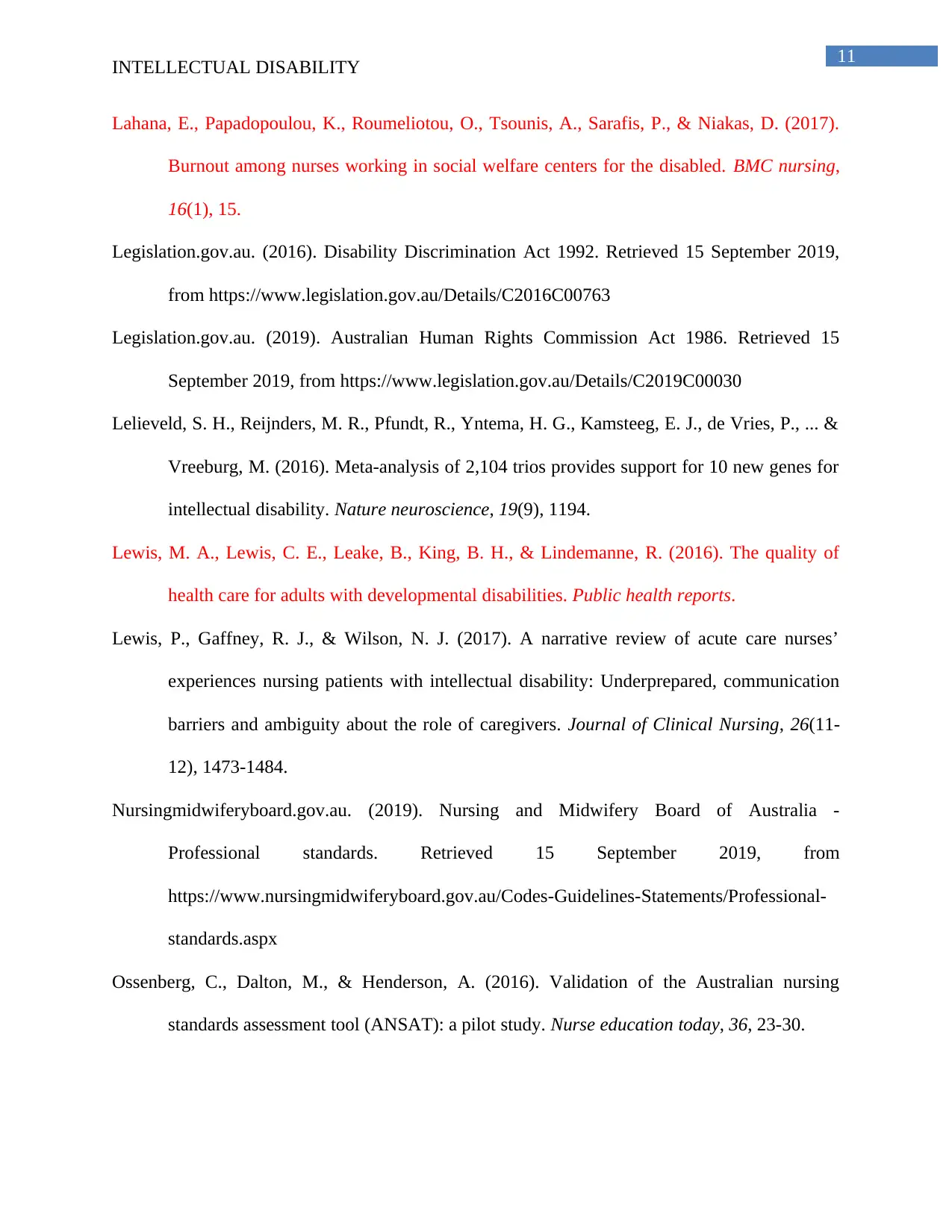
11
INTELLECTUAL DISABILITY
Lahana, E., Papadopoulou, K., Roumeliotou, O., Tsounis, A., Sarafis, P., & Niakas, D. (2017).
Burnout among nurses working in social welfare centers for the disabled. BMC nursing,
16(1), 15.
Legislation.gov.au. (2016). Disability Discrimination Act 1992. Retrieved 15 September 2019,
from https://www.legislation.gov.au/Details/C2016C00763
Legislation.gov.au. (2019). Australian Human Rights Commission Act 1986. Retrieved 15
September 2019, from https://www.legislation.gov.au/Details/C2019C00030
Lelieveld, S. H., Reijnders, M. R., Pfundt, R., Yntema, H. G., Kamsteeg, E. J., de Vries, P., ... &
Vreeburg, M. (2016). Meta-analysis of 2,104 trios provides support for 10 new genes for
intellectual disability. Nature neuroscience, 19(9), 1194.
Lewis, M. A., Lewis, C. E., Leake, B., King, B. H., & Lindemanne, R. (2016). The quality of
health care for adults with developmental disabilities. Public health reports.
Lewis, P., Gaffney, R. J., & Wilson, N. J. (2017). A narrative review of acute care nurses’
experiences nursing patients with intellectual disability: Underprepared, communication
barriers and ambiguity about the role of caregivers. Journal of Clinical Nursing, 26(11-
12), 1473-1484.
Nursingmidwiferyboard.gov.au. (2019). Nursing and Midwifery Board of Australia -
Professional standards. Retrieved 15 September 2019, from
https://www.nursingmidwiferyboard.gov.au/Codes-Guidelines-Statements/Professional-
standards.aspx
Ossenberg, C., Dalton, M., & Henderson, A. (2016). Validation of the Australian nursing
standards assessment tool (ANSAT): a pilot study. Nurse education today, 36, 23-30.
INTELLECTUAL DISABILITY
Lahana, E., Papadopoulou, K., Roumeliotou, O., Tsounis, A., Sarafis, P., & Niakas, D. (2017).
Burnout among nurses working in social welfare centers for the disabled. BMC nursing,
16(1), 15.
Legislation.gov.au. (2016). Disability Discrimination Act 1992. Retrieved 15 September 2019,
from https://www.legislation.gov.au/Details/C2016C00763
Legislation.gov.au. (2019). Australian Human Rights Commission Act 1986. Retrieved 15
September 2019, from https://www.legislation.gov.au/Details/C2019C00030
Lelieveld, S. H., Reijnders, M. R., Pfundt, R., Yntema, H. G., Kamsteeg, E. J., de Vries, P., ... &
Vreeburg, M. (2016). Meta-analysis of 2,104 trios provides support for 10 new genes for
intellectual disability. Nature neuroscience, 19(9), 1194.
Lewis, M. A., Lewis, C. E., Leake, B., King, B. H., & Lindemanne, R. (2016). The quality of
health care for adults with developmental disabilities. Public health reports.
Lewis, P., Gaffney, R. J., & Wilson, N. J. (2017). A narrative review of acute care nurses’
experiences nursing patients with intellectual disability: Underprepared, communication
barriers and ambiguity about the role of caregivers. Journal of Clinical Nursing, 26(11-
12), 1473-1484.
Nursingmidwiferyboard.gov.au. (2019). Nursing and Midwifery Board of Australia -
Professional standards. Retrieved 15 September 2019, from
https://www.nursingmidwiferyboard.gov.au/Codes-Guidelines-Statements/Professional-
standards.aspx
Ossenberg, C., Dalton, M., & Henderson, A. (2016). Validation of the Australian nursing
standards assessment tool (ANSAT): a pilot study. Nurse education today, 36, 23-30.
⊘ This is a preview!⊘
Do you want full access?
Subscribe today to unlock all pages.

Trusted by 1+ million students worldwide
1 out of 13
Related Documents
Your All-in-One AI-Powered Toolkit for Academic Success.
+13062052269
info@desklib.com
Available 24*7 on WhatsApp / Email
![[object Object]](/_next/static/media/star-bottom.7253800d.svg)
Unlock your academic potential
Copyright © 2020–2025 A2Z Services. All Rights Reserved. Developed and managed by ZUCOL.





